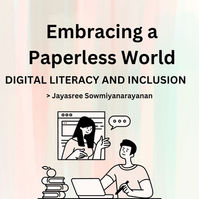"Education is the most powerful weapon with which you can change the world." -Nelson Mandela
EDUCATION
Education is the most significant factor of an Economy. It helps design a person on who they become and what they become; it allows the nation with the literacy rate while directly increasing the economy’s value. Education develops a spirit of inquiry and rational thinking in youth, which helps them, model into resourceful citizens. The Indian Education System is one of the largest globally, with more than 1.5 million schools, 8.5 million teachers, and 250 million children.
BIRTH OF EDUCATION IN INDIA
India’s education system dates back to around 5000 BC; the first system known as Gurukul was a residential schooling system, where shishya(student) and guru(teacher) reside in the guru’s ashram. This gave rise to an emotional bond between the guru and the shishya before spreading knowledge. Children were sent to gurukuls at the age of six and returned home at 16 with a mind of knowledge, power, and self-reliance.
The learning mode wasn’t only from books, but an all-rounded development of a child, consisting of physical, mental, logical, and spiritual wellness. They were taught from mythological books experiences; they were also informed on medicine, astrology, art, and more.
This education system began early during the Vedic age when there was no specific form of formal education. Still, the knowledge was skill-based and religiously ingrained in Vedas, Puranas, and holy texts, which were the authoritative guide for students to expand their horizons of knowledge.
By the grace of the guru, a disciple becomes a scholar even without reading books -Swami Vivekananda
LEVELS OF EDUCATION
Education in India follows an even school education structure known as the 10+2 system. This system is being pursued through all Indian States and Union Territories. But not all of them follow a different pattern as per the system. There are broadly three phases of school education in India: primary, secondary and higher secondary, and Higher Education. Overall, schooling lasts 12 years. Although, there are significant differences between the various states regarding the administrative patterns within these first 10 years of schooling.

ACADEMIC CURRICULUM
India has 3 national boards and other state boards that conduct board examinations for students in 10th and 12th across India.
● Central Board of Secondary Education (CBSE)
The CBSE is a national education board with over 24,000 schools in India and around 240 schools in 26 foreign countries.
The Board conducts examinations for regular as well as private students. Candidates who wish to take up schooling in a distance mode can apply for admissions and sit for exams. CBSE offers numerous subjects to its students after class 10th in Science, Commerce and Arts stream. After completing class 12th, students can apply for admission to various colleges/universities to pursue higher education.
● Council for the Indian School Certificate Examinations (CISCE)
CISCE is a privately held national-level board of school education in India that conducts the Indian Certificate of Secondary Education (ICSE) and the Indian School Certificate (ISC) examinations for Class 10th and12th, respectively.
The Council conducts board examinations for Class 10th and 12th every year in February and March. In 2021-22, they’re now running boards twice a year due to the pandemic caused by a coronavirus.
● National Institute of Open Schooling (NIOS)
NIOS is the Board of Education under the Union Government of India. It was recognized by the Ministry of Human Resource Development (MHRD) of the Government of India in 1989 to provide education to all sections of society under the motive to increase literacy and intended forward for flexible learning.
IMPORTANCE OF EDUCATION
Everything in life is not permanent, life even. Suppose you purchase a piece of land today. In that case, it may be gone in a week, month, year, or a decade, but Education is constant, you still remember alphabets, most of the rhymes you learned in nursery, so if there’s one thing nobody can take away from you, it is knowledge.
Education for a child begins at home; it’s a continuous process that ends with death, no one ever stops learning. To say that Education is important is an understatement; Education is a constant tool to improve one’s life; it determines the quality of an individual developing their personality and attitude. Moreover, it increases the chances of employment in one’s life.
First off, Education teaches us to read and write, which is basic and important, or a foundation to Education. Enhanced Communication is yet another role in Education. Education advances and polishes the speech of a person. Besides, individuals also improve other means of communication with Education.Enhanced Communication is yet another role in Education. Education advances and polishes the speech of a person. Besides, individuals also improve other means of communication with Education.
“Education is the passport to the future, for tomorrow belongs to those who prepare for it today.” -Malcolm
IMPORTANCE OF SEX EDUCATION, GENDER IDENTITY, AWARENESS OF BULLYING, ETC IN ACADEMIC CURRICULUM
For the Indian society, sex still remains a matter to be conversed inside the closed doors of the bedroom instead of talking about it in public spaces to create more awareness. Most children are not aware of good and bad touch, which leads to many sexual child abuse cases. When a child is educated on sex, consent, and abuse, they know when to stop an individual from causing any harm to them.
Benefits of sex education
● Build a healthy foundation for lifelong sexual health. This is done by finding information and attitudes, opinions, and values about identity, relationships, and intimacy.
● Sexual health is stared at as a state of physical, emotional, mental, and social well-being concerning sexuality and not just the absence of disease or infirmity as defined by the World Health Organization (WHO).
● During adolescence (12–19 years) its establishment is an important preventative tool. It is a suitable time when young people experience developmental changes in their physiology and behavior as they enter adulthood.
The education system in India has modelled many achievers, but still less compared to the nations in the world. Indian Education is sophisticated and focuses more on the curriculum rather than the overall development. The curriculum followed in schools is very disconnected from life. It does not prepare the child for everyday life as it is. We hope for this to change as children need to learn moral values and be prepared to face any challenge thrown by life.
NEP (National Education Policy)
In 2020, the government bought in a new education policy that benefits students on a larger scale; they are given the choice of choosing majors at a young age, giving them a chance for decision-making. This policy has more options of focusing on the child’s overall personality growth rather than just academic growth.
CONCLUSION
Education has and will be a vital part of everyone’s life; it must be prearranged, updated, and modified on so many levels before giving it to children. Education may not just come from schools; it first starts at home and, at the end of the day, ends at home, so parents must also be well informed on what their children should receive and be prepared to give them as much as they can.











Informative!
Good job ruchitha ✨
😁Good job Ruchi!
Very nice sister💐
Opps beautifully put accross,covered almost all aspects of education.. keep up your wonderful work...